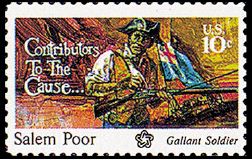James Otis is one of the Boston men who helped stoke the fires of revolution during the 1760s. In fact, some people may say that he is the man who lit the fire. He is not as well known and he was not as prolific in his speeches and political work as many of his fellow revolutionaries. However, he was among the most intelligent and dedicated of these men. Sadly, his years of dedication and public service ended tragically.
James Otis was born on February 5, 1725 in West Barnstable, Massachusetts to James Otis Sr. and Mary Otis nee Allyne. His father was in politics. James Otis Jr. attended Harvard College. He graduated in 1743, at the age of eighteen. From there, he went to study law under Jeremiah Gridley.
James Otis' career in law began in 1748. He practiced in Plymouth, Massachusetts. However, Plymouth did not have a great need for a lawyer at the time, so two years later, James Otis took his practice into Boston. There, he earned a name for himself as a great speaker and a highly intelligent man. During the 1750s, John won a case that earned him the largest sum ever paid to a lawyer in Massachusetts until that time. His career was looking very promising.
In 1755, James Otis married Ruth Cunningham. The couple would go on to have three children together, James, Elizabeth and Mary. At the time of their marriage, they were both loyalists. That would change for James. Ruth would remain loyal to England for the remainder of her life, which, as it turns out, was longer than James' was.
James Otis shared his wife's beliefs openly until 1961. Around that time, some British revenue officers were given the authority to search the homes and places of business of Boston merchants in search of smuggled goods. James Otis decided to leave his then current position as advocate-general and represent Boston's affected merchants, for free. When the case was heard in what is now known as the Old State House, James Otis gave a roughly five-hour-long speech, addressing this issue and much more. One of his focuses was the fact that colonists had to follow Parliament's laws when the colonists were not represented in Parliament. He lost the case. However, the impact his speech had can be summed up by what future president of the United States John Adams said later. He remarked that it was on that day in the Old State House that "the child independence was born."
Soon after James Otis gave his speech at the Old State House, he was elected to the Massachusetts General Court. In 1764, he became a leader of the Massachusetts Committee of Correspondence. That same year, he wrote his famous pamphlet, "The Rights of the Colonies Vindicated." A year later, he attended the Stamp Act Congress in New York City.
In 1769, James Otis made some negative comments in the Boston Gazette that were directed at a few revenue officers. One of those customs officers and some British military men found James a few days later and mercilessly beat him. He sustained a head injury that contributed to the decline of his mental health. James Otis was able to hold on to his sanity for long enough to sue his attacker. He was rewarded a sum of money, but he would not accept it. He also received a formal apology. He remained in public office for a few more years, but by the time the American Revolution began, he was insane and in the care of his sister, Mercy Otis Warren. His life would be dotted with a few brief periods of lucidity, but he was never the same man again. He did however contribute to the American Revolution in a way that you probably will not expect.
On June 17, 1775, James Otis, then 50-years-old, decided to procure a musket and walk to Breed's Hill. That day, on Breed's Hill, a battle was raging that would become known as the Battle of Bunker Hill. James Otis showed up for the battle, fought in it, and walked home. Obviously, his hopes for the future of the country followed him in his descent into insanity.
Most of the rest of James Otis' life was spent in Andover, Massachusetts. He was there on May 23, 1783 when he was struck by lightning and killed instantly. A brilliant and at times odd life ended there. James was buried at the Granary Burying Ground in Boston, Massachusetts.
SourcesJames Otis, retrieved 5/22/10, famousamericans.net/jamesotis
James Otis, retrieved 5/22/10, u-s-history.com/pages/h1204.html



